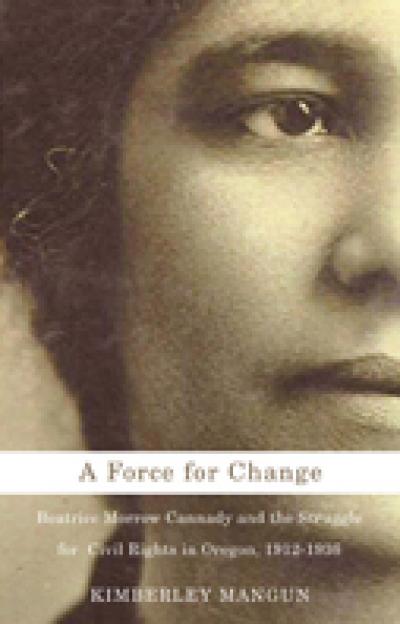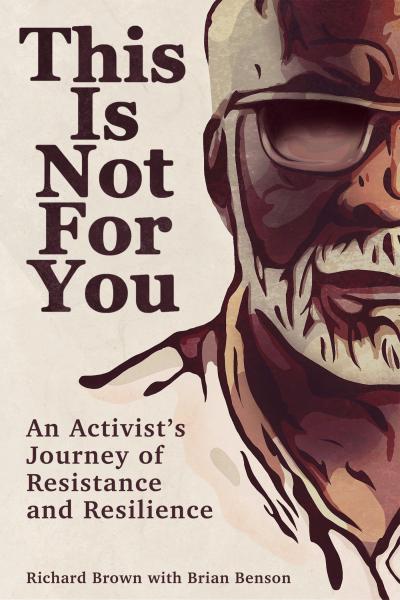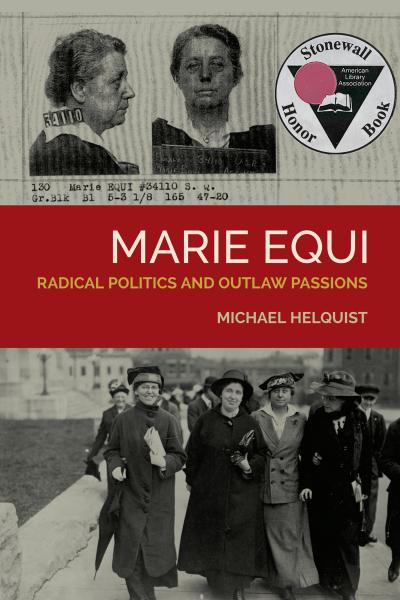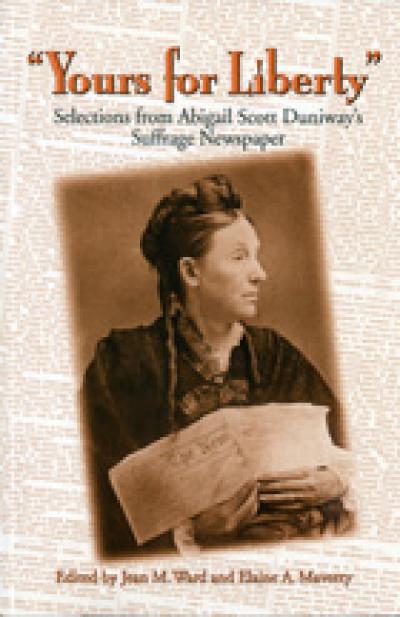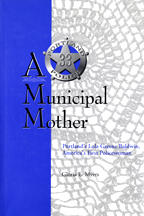
A Municipal Mother
Gloria E. Myers
On April 1, 1908, Lola G. Baldwin, aged forty-eight, was sworn in "to perform Police Service" for the city of Portland, Oregon. She was the first woman hired by an American municipality to carry out regular enforcement duties. The municipal policewoman movement originated in Portland, and first proved its viability in the cities of the Northwest.
In telling Lola Baldwin's story, Gloria Myers examines the social and cultural impulses that gave rise to the policewoman idea. The Progressive Era redefined the role of women in society; Baldwin's career benefited from the Progressive belief that women could ameliorate urban evil as they had earlier civilized the household. The need for the urban policewoman arose out of concern for the moral and physical welfare of families, single working women, and children living in the cities. Supported by socially active women's organizations and informed by the ideals of "social hygeine," the first policewoman led a crusade against urban vice, deviance, and corruption in the Rose City. Preventive policing strategies developed by "municipal mothers" like Baldwin aid and influence policing policies to this day.
Lola Baldwin's fascinating story evokes the flavor of urban life in ragtime America, when police power increasingly became the watchdog of social morality.
About the author
Gloria E. Myers is a freelance researcher and historical writer in Portland. She earned an M.A. in History from Portland State University in 1993, and is currently researching the life of a Portland suffragist.
Read more about this author
Preface
Introduction
1. "A Municipal Mother"
2. Working Girls and Women Police
3. The Dance Hall as Moral Menace
4. The Policewoman as Cultural Censor
5. Combating Sexual Delinquency
6. Thwarting the "Social Evil"
7. Women, Politics, and Penology
8. Defending "Moral Martial Law"
9. Toward a New Profession
10. Epilogue
11. Conclusions
Appendix
Notes
Bibliography
Index
In February 1911, pioneering American juvenile court judge Benjamin Lindsey, speaking before a mass meeting of suffragists in Albany, New York, stated that he believed that women who worked as police and probation officers "each had done more good than forty men would or could have." In 1913, Chicago social worker Louise de Koven Bowen impressed national readers of The Survey with the need for what she termed "policewomen." Only females with full police power, she asserted, could "cope with certain dangerous situations with which private organizations have tried in vain to deal." By 1920, police reform expert Raymond B. Fosdick wrote that the policewomen's movement was already "of supreme significance" in the evolution of law enforcement in the United States. Although the profession was only a dozen years old, he noted that women police had proved especially successful in the active investigation and prevention of female vice crime. This work traces the emergence of the policewoman idea through a case study of the career of Lola Greene Baldwin of Portland, Oregon, the first woman hired by an American municipality to carry out regular enforcement duties.
In late 1907, under pressure from a coalition of local women's interest groups and anti-vice forces, the Portland City Council agreed to fund several positions for women in the police department. It directed the civil service commission to add the category of "Female Detective" to its classified examinations list, and subsequently passed an ordinance that specified police budget monies "to provide for the expenses of affording protection to young women and girls." On April 1, 1908, Lola G. Baldwin, aged forty-eight, was sworn in "to perform Police Service" under the direction of the chief of police. She was not, however, the passive beneficiary of a job concocted by the male civic hierarchy. She had forged the role herself and, with the aid of women's organizations and male sympathizers, successfully convinced authorities that it was a necessary adjunct to Rose City policing.
The infant municipal policewomen's movement was an outgrowth of several impulses which coincided during the Progressive Era. The foremost of these was a redefinition of the role of women in society. The nineteenth century's cult Of true "womanhood," which confined women as civilizing and purifying agents within the home, began to give way to more public reform opportunities at the end of the century. By the 1890s, many elite and middle-class women began to organize to effect social change in the civic sphere.
These "social feminists" chose issues which were consistent with their traditional nurturing roles and supposed moral superiority. In the cities, educated women began settlement houses in poverty-stricken immigrant working-class sectors. Rather than dispense charity at arms length, they lived among the less fortunate as neighbors, and began programs to Americanize recent arrivals and uplift the native-born poor. Settlements offered classes in everything from citizenship and English language to health and occupational training. Vice-conscious workers tried to divert the locals from the traditional recreation options of the saloon and the prostitute. Other socially concerned women, observing the success of places like Chicago's Hull House, joined in a nationwide campaign to improve urban conditions through what one historian referred to as an "imposition of middle-class culture and values on the lower classes."
Insisting on a legitimate right to be municipal housekeepers, various women's civic reform, literary, and improvement societies banded together in 1890 as the General Federation of Women's Clubs. The Federation subsequently cooperated with existing organizations like the Women's Christian Temperance Union (WCTU), Young Women's Christian Association (YWCA), the new urban settlement workers, and others. The result was a powerful consortium which, in the period between 1890 and World War 1, addressed diverse problems affecting women, children, and families. Together, they called for school improvements, public health codes, women's suffrage, the hiring of women as police officers and jail matrons, measures against juvenile delinquency, protective laws for minor and female workers, prostitution abatement, policing of amusements, alcohol restriction, and other issues which touched directly upon American home-life. They became part of a female dominion within social reform which endured for years.
The urban policewoman appeared in response to distaff concerns for the moral safety of transient women and girls. Initially, under a temporary special police authority, Lola Baldwin was commissioned by a Travelers' Aid board dominated by social feminists to watch over females who came as visitors or to find work at Portland's 1905 world's fair. Three years later, under permanent police powers, her emphasis shifted to protecting those enticed by new employment opportunities. Low-skilled, unmarried young women were flocking to expanding cities like Portland to find blue-collar, white-collar, or domestic jobs. Many of these "women adrift" lived independently in boarding houses or housekeeping rooms. Both young native-born and immigrant women, away from the controlling influence of family for the first time, were felt to be imperiled by seductive vice elements. Urban reformers were alarmed by an immigrant culture they considered immoral, ubiquitous saloons, and rampant prostitution. Although working girls were especially vulnerable, the reformers thought the cities held pitfalls for females of all ages and classes. The municipal policewoman was but one of the "maternal" responses initiated by the social-feminist reform coalition.
The study of Baldwin's career reveals a culturally conservative, gender-specific policing strategy. Through measures designed to preserve traditional standards as the norm, she and others labored to codify the Victorian model of female moral purity, and make it relevant to the post-Victorian city. She and her reform cohort evolved an elaborate institutional apparatus of social control to deal with what they defined as deviant behavior. They targeted the female "sexual delinquent" as the anti-thesis of their ideal of a standardized social morality ethic. Government and private preventive and corrective activities consumed their attention. In Portland, between 1905 and 1918 alone, Baldwin and other social feminists, in cooperation with male reformers, helped found the municipal policewomen's division, juvenile, morals, and domestic relations courts, a citizen vice commission, a state institution for sexually delinquent girls, a city venereal detention hospital for prostitutes, and pushed a variety of state and local protective legislation for women and children.
Baldwin's active policing years (1905 to 1922) coincide with the rise and gradual decline of the progressive ethos in the United States. An analysis of her work offers a look at the response of one individual and her supporters to that impulse over time. The period's major social battles over juvenile delinquency, censorship, prohibition, amusement reform, prostitution, and venereal disease all affected the first policewoman's agenda. As a "Municipal Mother," as contemporary Louise Bryant described her in a Sunset magazine piece, Baldwin benefited from the Progressive Era belief that women could ameliorate urban evil as they had earlier civilized the household. Although not without difficulty, this ideology allowed her to establish a lasting and legitimate employment niche for her sex within law enforcement. She embodied the American woman's transition from Victorian seclusion to post-Victorian acceptance as a traditionalist, nurturing, morally conservative activist in the public sphere. Her story, set in Portland, evokes the flavor of urban life in ragtime America, when the police power increasingly became the watchdog of social morality.
The vogue for women's civic activism caught fire in Portland after 1900, when the city began experiencing exponential growth, although a strong female reform element was already present prior to that time. Frances Willard, president of the national organization, personally delivered the charter to the Portland branch of the Women's Christian Temperance Union (WCTU) in 1883. Like its parent, the local WCTU involved itself in much more than the alcohol question. From its inception, for example, it championed "equal rights at the ballot box." One of its first projects was a program to educate children on the evils of alcohol. In 1888, it opened a foundling's home for orphaned or abandoned babies in East Portland. In the early 1890s, it began an industrial home for women and girls in the working-class section of the North End which included a kindergarten, a day nursery, and a sewing school. Several years later, it operated a home for unwed mothers. After 1900, the WCTU actively campaigned for child labor laws, raising the age of consent for sexual relations from fourteen to eighteen years, women's protective legislation, city policewomen, jail matrons for female prisoners, and tobacco and alcohol restrictions.
The patrician Portland Woman's Club was founded in 1895. It supported women's education efforts, specialized social service aid programs, suffrage, vice prevention, and protective legislation. Noted member Abigail Scott Duniway led the fight for the women's franchise in Oregon. Sarah A. Evans began nutrition and cooking classes for working women, and discovered filthy conditions in the city's food markets. When she initiated a public campaign for sanitary laws and inspection, she was appointed market inspector by Mayor Harry Lane. Millie Trumbull, who lived as a settlement worker at Chicago's Hull House for a time, was secretary of the Oregon chapter of the national Conference of Charities and Corrections. She inspired the organization of Portland's juvenile court, and became head of its probation department. Eleanor F. Baldwin wrote a column, "The Woman's Point of View," in the Evening Telegram which highlighted women's reform concerns, including the need for policewomen. Writer Louise Bryant, most noted for her suffrage activities, also boosted the women's police idea in the Oregonian newspaper and Sunset magazine.
The more egalitarian Portland Women's Union enjoyed a broader membership who shared an interest in moral reform, vice prevention, and women and children's protection through both public and private means. Its representatives were found on boards and as practical workers for institutions like the Florence Crittenton Home, Children's Home, Travelers' Aid, Boys and Girls Aid Society, and the Albertina Kerr and Fruit and Flower day nurseries. It had a number of well-to-do affiliates, but also drew from the ranks of the solid middle class, without regard to social pedigree. As one of its more successful projects, it ran homelike boarding houses for single female workers. A number of its members were instrumental in beginning Portland's first genuine settlement house.
In 1904, "The People's Institute Settlement Work" was established in the heart of the working-class residential North End. Although begun as a Presbyterian Mission project, it soon became a secular enterprise substantially backed by Helen Ladd Corbett of the Women's Union. it patterned itself after Jane Addams' Hull House in Chicago, accepting volunteer workers and contributions from all quarters. Valentine Pritchard, a kindergarten teacher and trained settlement worker, served as director. After visiting homes in the neighborhood, Pritchard provided services to meet the most pressing needs. She organized a kindergarten, a class for disabled children unable to attend regular school, an outdoor playground, and an indoor gymnasium program. She added a bathing and laundry room which local mothers could patronize with their children twice a week. Citizenship, hygiene, sewing, cooking, and mothering classes instructed immigrant women in expected cultural norms. An employment bureau for women and a free medical clinic were also provided.
With a long tradition of self-sufficiency, the Rose City's Jewish women responded to the needs of the Eastern European Jews who began to settle in South Portland in the 1890s. In 1896, the wives of Abraham Meier, Alex Bernstein, Ben Selling, L. Altman and others (their own names have not been preserved) organized the Portland Council of Jewish Women. One of its primary concerns was the moral safety of young female immigrants, few of whom could speak English. Its philanthropy committee sponsored a sewing class which was open to all, regardless of religious background. When Reform Rabbi Stephen S. Wise accepted a position at Portland's Temple Beth Israel in 1900, his wife Louise joined the council. She convinced the women to begin a Visiting Nurse Association to serve all the city's poor. With Rabbi Wise's blessing, the women established a Neighborhood Guild, which opened a settlement house in 1905. "Neighborhood House," as it was called, provided much the same programs to South Portland residents as the People's Institute did in the North End. It offered citizenship, cooking, sewing, drawing, crafts, and manual training classes. The complex also housed a gymnasium, kindergarten, library, medical services, and group meeting facilities.
The Portland Young Women's Christian Association (YWCA) was organized in 1900 as a haven for young women who moved to the city to find work. it provided safe low-cost rooms, meals, employment advice, enlightening lectures, and practical arts classes. In 1904, under president Jessie M. Honeyman, it began a Travelers' Aid department with funds from the National Exposition Travelers' Aid Association of New York. The aim of the program was to offer material help and guidance to young women arriving for the city's 1905 Lewis and Clark Exposition, and prevent them from being seduced or otherwise morally compromised while in the city. The Travelers' Aid idea had originated with the YWCA, which began one of the first programs in Chicago in 1888 "to outwit evil agents who would deceive the innocent." The nonsectarian National Travelers' Aid, however, welcomed purity advocates from all women's groups for ad hoc vice prevention in cities hosting large expositions. In keeping with this female ecumenism, Honeyman appointed Lucia F. Addington of the Woman's Club and WCTU, Josephine Hirsch of the Women's Union and Council of Jewish Women, and Mrs. C. R. Templeton, also of the Women's Union, to serve as officers. Lola G. Baldwin of the Florence Crittenton Home board was chosen as program director.
Other religious and ecumenical organizations were also a vital part of the vice-control and social-service network. Urban missions served a clientele often ignored by more fastidious workers. The women's auxiliaries of the Olive Branch, Peniel, and Salvation Army missions aided the most downtrodden of society from locations in the heart of the vice district. They provided refuge for abused prostitutes with no questions asked, for example, and dealt with women ravaged by alcohol and drug addiction. The Olive Branch Mission worked with the municipal policewomen by visiting prostitutes in the neighborhood and handing out cards directing them to the Women's Protective Division for help in leaving prostitution if they desired. The Volunteers of America ran a boardinghouse for working-class women on the east side's Union Avenue. The Catholic Women's League, besides serving the needs of their own, supported worthy outside causes. Of note was their financial sponsorship of an additional Travelers' Aid matron at Union Depot. They began a free employment bureau, and took probationed Catholic girls under their wing to ease the burden on the city's policewomen. The Catholic Sisters of the Good Shepherd operated what was for years the city's only detention home for delinquent minor females remanded by the courts or their parents as incorrigible.
The municipal policewomen's movement was also heavily influenced and aided by the ideals of "social hygiene," a reform avenue often utilized by the social-feminist coalition. Inspired by medical germ theory, social hygiene principles dominated many of the attempts to bring rational order to America's urban areas at the beginning of the twentieth century. The goal was to cleanse and uplift the evil city, and make it morally and physically safe for families, single working women, and children. Advocates believed that the police power should be utilized to attack a broad range of concerns. Under pressure from social hygienists, many of whom were physicians, municipalities initiated sanitation and public health programs, venereal disease control, vice and prostitution abatement, commercial amusement reform, and other correctives for situations perceived as dangerous to the public welfare.
Portland Mayor Harry Lane, a practicing physician, was the city's first public officer who could be called a social hygienist. He ran for mayor in 1905 after Mayor George Williams rebuffed his proposal for a meat inspection code to regulate practices in local packing houses. He was equally incensed with the sexual vice and venereal disease in the North End. As mayor, he reorganized the city health department, and appointed Dr. Esther Pohl Lovejoy as Health Officer to fill a position which had simply been a political plum in the past. Like Lane, Lovejoy believed that prostitution and venereal disease were public health threats as well as moral issues, and should be controlled by the police power. Lane's appointment of Sarah Evans as market inspector furthered his approval of women as "municipal housekeepers," but his advancement of the policewoman idea was undeniably his most important gesture to include women in his plan to cleanse Portland of corrupting vice.
Oregon Governor George Chamberlain, who served at the same time as Lane and shared his antivice zeal, was considered a pioneer social hygienist by the national movement. In 1908, both Lane and Chamberlain endorsed Portland physicians L. W. Hyde, Calvin White, and Norman Pease, who followed the lead of New York's Dr. Prince Morrow and formed a Social Hygiene Society to gather evidence on sexual vice and related issues and lobby for remedial actions. Dr. Hyde invited new policewoman Lola Baldwin, juvenile court judge William N. Gatens, and juvenile probation department head Millie Trumbull to join as charter members. In 1911, at the urging of Harvard-trained president of Reed College Dr. William T. Foster, the Portland society affiliated with the American Federation for Sex Hygiene and changed its name to the Oregon Social Hygiene Society. Its expanding male and female membership was instrumental in initiating statewide sex and venereal disease education, a vice commission to study prostitution and venereal disease in Portland, and state and local vice reform and health legislation.
These two impulses, then--organized social feminism and the social hygiene ethic--became the most important guiding influences on the municipal policewomen's movement. Female interest in these issues was based in traditional concerns for family, and the welfare of women and children. As avenues for reform became increasingly secular, or at least secular-sounding, the principles of social hygiene enabled women to advocate use of the government police power to gain social change. Fearing prostitution and disease for the young woman who remained unprotected in the city, "municipal mothers" like Baldwin sought female-to-female preventive solutions. Social hygienists' insistence that prostitution was a public health problem opened up the legitimate use of the police power to fight urban vice in general, as most forms of it could be linked in some way to the ,oldest profession." Both the women's organizations and the social hygiene element proved to be faithful supporters of Baldwin's policing agenda over time.
"A bang-up research job… Baldwin was a pioneer in her field, whose influence spread across the country, and Myers does her justice in this timely, thorough book."
"Written clearly and concisely, the book should interest general readers as well as students and faculty in criminal justice and women's studies programs."

